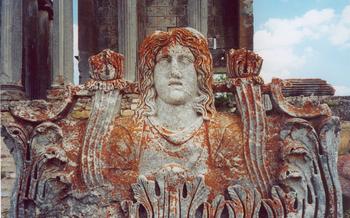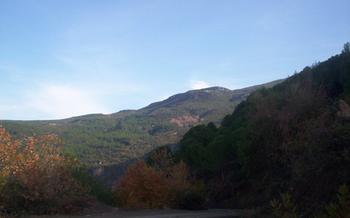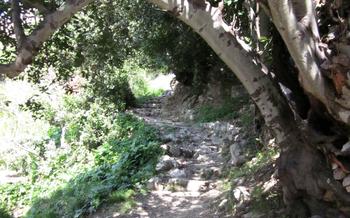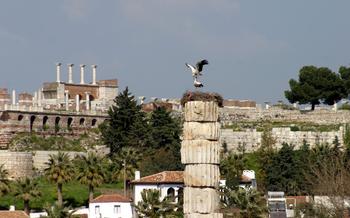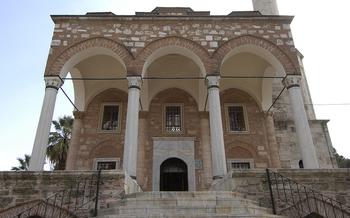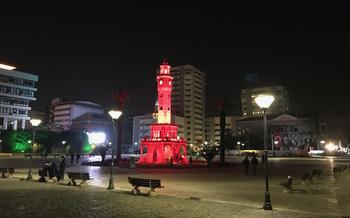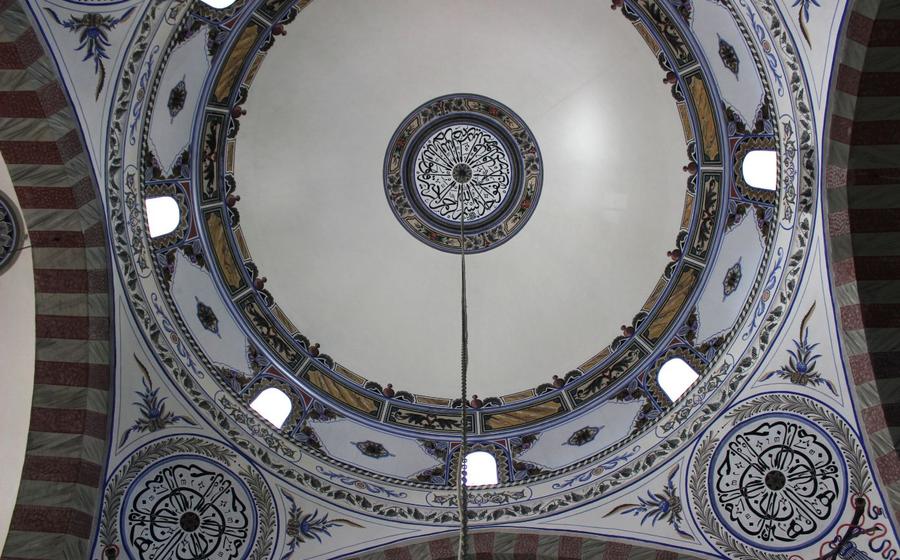
Cavdarhisar Aizanoi Antique City
- A Journey to Aizanoi: A Historical Gem
- Navigating Aizanoi: How to Get There
- Opening Hours and Fees: Plan Your Visit
- Marvels of Aizanoi: The Theater
- Temple of Zeus: A Divine Abode
- Odeon of Aizanoi: A Stage for Performances
- Agora: The Heart of Aizanoi
- Aizanoi Museum: Unveiling the Past
- Perge Gate: A Gateway to Grandeur
- Stadium: Arena of Ancient Sports
- Necropolis: Eternal Resting Grounds
- Aqueduct: An Engineering Marvel
- Nature's Embrace: Aizanoi's Environs
- Food and Accommodation: Local Delights
- Insider Tip: A Unique Perspective
A Journey to Aizanoi: A Historical Gem
Aizanoi, an ancient city located in the picturesque province of Kütahya, Turkey, beckons history buffs and culture enthusiasts alike. This well-preserved archaeological site, dating back to the 3rd century BC, offers a glimpse into a glorious past, where the echoes of ancient civilizations reverberate.
Aizanoi's strategic location at the crossroads of important trade routes made it a prosperous and influential city throughout history. It served as a significant center for trade, agriculture, and religious practices, leaving behind a rich legacy that continues to captivate visitors.
The city's historical significance is intertwined with major events that shaped the region. It was once part of the powerful Pergamon Kingdom, then fell under Roman rule, and later became an important city within the Byzantine Empire. Each era left its mark on Aizanoi's architecture, culture, and traditions, creating a tapestry of diverse influences that tell a story of resilience and transformation.
Navigating Aizanoi: How to Get There
Reaching the ancient city of Aizanoi is an adventure in itself, taking you through picturesque landscapes and historical routes. The city's convenient location allows for easy access from major cities in Turkey.
Transportation Options:
- By Road: Embark on a scenic road trip from nearby cities like Bursa, Eskişehir, or Kütahya. Follow well-maintained roads, enjoying the countryside views.
- By Public Transport: Buses and minibuses frequently depart from regional transportation hubs, offering a budget-friendly option. Check local schedules for timings.
- Organized Tours: Join a guided tour from regional cities. These tours often combine Aizanoi with other nearby attractions, ensuring a comprehensive experience.
Routes and Directions:
- From Bursa: Take the scenic route along the D-200 highway, enjoying views of Uludağ (Mount Olympus). The journey takes approximately 2 hours.
- From Eskişehir: Embark on a 5-hour drive via the D-650 highway, passing through quaint towns and agricultural landscapes.
- From Kütahya: Drive for about 45 minutes on the D-230 highway, immersing yourself in the region's historical charm.
Hassle-Free Journey Tips:
- Car Rental: Consider renting a car for flexibility and comfort, especially if exploring multiple sites in the region.
- Local Advice: Consult with locals or tourist information centers for the most up-to-date transportation information.
- Early Start: Begin your journey early to avoid crowds and make the most of your time at Aizanoi.
Opening Hours and Fees: Plan Your Visit
Before embarking on your journey to Aizanoi, it's essential to plan your visit by considering the operating hours and admission fees. The Aizanoi Antique City is generally open to the public every day of the week. However, it's advisable to check the official website or contact the local tourism office for any updates or special closures.
Admission fees are typically charged for entry into the site. The standard ticket price includes access to all the ruins and attractions within the ancient city, including the theater, Temple of Zeus, Odeon, Agora, and other significant monuments. Reduced rates may be available for students, children, or senior citizens.
To make the most of your visit, it's recommended to allocate at least half a day to explore the extensive ruins of Aizanoi. Comfortable walking shoes and sun protection are essential, especially during the hot summer months. It's also a good idea to bring water and snacks, as there are limited food and beverage options available on-site.
For budget-conscious travelers, there are several ways to save on expenses. Consider visiting during the off-season (November to March) when tourist crowds are smaller, and admission fees may be discounted. Taking advantage of combined tickets that offer reduced rates for multiple attractions in the region is another smart move. With a bit of planning, you can experience the wonders of Aizanoi without breaking the bank.
Marvels of Aizanoi: The Theater
In the heart of the Aizanoi Antique City, the Ancient Theater stands as a testament to the city's cultural significance. This architectural marvel, built in the 2nd century AD, boasts a seating capacity of approximately 20,000 spectators. Its impressive design showcases a blend of Greek and Roman influences, with tiers of marble seats rising in concentric rows. The theater's acoustics are remarkable, allowing performers' voices to carry effortlessly throughout the auditorium. In ancient times, it hosted theatrical performances, musical concerts, and civic gatherings, playing a vital role in the city's cultural and social life. Today, visitors can marvel at the theater's grandeur, imagining the vibrant atmosphere and entertainment that once filled this ancient venue.
Temple of Zeus: A Divine Abode
A testament to the grandeur of Aizanoi's religious devotion, the Temple of Zeus stands as a majestic edifice, its history interwoven with tales of ancient rituals and divine reverence. Constructed during the Roman period, the temple served as the city's primary place of worship, dedicated to the supreme deity of the Greek pantheon.
The architectural design of the temple embodies classical elegance, featuring a rectangular plan and a series of imposing columns that frame the entrance. Intricate carvings adorn the capitals and friezes, depicting scenes from Greek mythology and symbolizing the power and majesty of Zeus.
Within the temple, a colossal statue of Zeus once stood, its presence commanding awe and veneration. Though the statue has not survived the passage of time, its absence only amplifies the sense of grandeur that lingers in the air, evoking the fervor and devotion of Aizanoi's ancient inhabitants.
The Temple of Zeus was not merely a place of worship but also a center for religious ceremonies and festivals. Here, the people of Aizanoi gathered to celebrate the glory of Zeus, offering sacrifices and performing sacred rituals to honor his divine presence.
As you stand amidst the ruins of the Temple of Zeus, let your imagination transport you back to a time when the temple was alive with activity, when the air was thick with incense, and the voices of worshippers echoed through the sacred space. Feel the weight of history as you marvel at the enduring legacy of this magnificent structure, a testament to the enduring power of faith and devotion in ancient Aizanoi.
Odeon of Aizanoi: A Stage for Performances
In ancient times, the Odeon of Aizanoi served as a vital cultural hub, hosting a variety of performances and events. Unlike the grand theater, the Odeon was a smaller structure designed specifically for musical and theatrical productions. With its intimate setting and exceptional acoustics, this venue provided an ideal atmosphere for captivating performances.
The Odeon's architectural design showcases intricate details and unique features. Its well-preserved stage is flanked by elegant columns and decorative elements, creating a visually stunning backdrop for performances. Intricate carvings and moldings adorn the walls, hinting at the rich artistic heritage of Aizanoi.
Acoustics were of paramount importance in the Odeon. The structure was carefully crafted to amplify and enhance the sounds produced by musicians and actors. The rounded shape of the auditorium, combined with the strategic placement of niches and recesses, ensured that every seat offered an optimal acoustic experience.
The Odeon played a vital role in the cultural life of Aizanoi. It hosted a variety of performances, including musical concerts, theatrical plays, and poetry recitals. These events brought the community together, providing entertainment, inspiration, and a sense of shared cultural identity.
Agora: The Heart of Aizanoi
The Agora, the bustling heart of Aizanoi, served as the city's central marketplace and gathering place. This expansive square was lined with shops, stoas (covered walkways), and merchants selling a variety of goods. The Agora was a place of commerce, social interaction, and civic life, where locals and visitors alike came to trade, exchange news, and conduct business.
The shops in the Agora offered a diverse array of products, from fresh produce and spices to textiles and pottery. Merchants set up stalls and displayed their wares, creating a vibrant and colorful atmosphere. The stoas provided shelter from the sun and rain, allowing shoppers to browse and make purchases in comfort.
The Agora was not just a place of trade but also a center for social gatherings and public events. Citizens would meet in the square to discuss politics, share stories, and catch up on the latest news. Festivals, celebrations, and religious ceremonies were often held in the Agora, bringing the community together.
The economic significance of the Agora was immense. It was the hub of Aizanoi's economy, where goods from all over the region were traded and exchanged. The Agora's vibrant commercial activity contributed to the city's prosperity and growth.
Aizanoi Museum: Unveiling the Past
In the heart of the Aizanoi Antique City, the Aizanoi Museum stands as a repository of the city's rich history and cultural heritage. This treasure trove of archaeological wonders invites visitors on a journey through time, showcasing artifacts that bring the ancient city's past vividly to life.
The museum's collection is a testament to Aizanoi's significance as a major cultural and economic center in ancient times. Exquisite sculptures, intricate mosaics, finely crafted pottery, and bronze artifacts offer a glimpse into the city's artistic prowess and craftsmanship. Coins, jewelry, and religious objects provide insights into the daily lives, beliefs, and customs of Aizanoi's inhabitants.
Among the museum's highlights are a stunning statue of the goddess Artemis, discovered in the Temple of Artemis, and a well-preserved mosaic depicting a hunting scene, uncovered in one of the city's luxurious villas. These masterpieces, along with many others, offer a glimpse into the artistic sensibilities and technical skills of Aizanoi's artisans.
A visit to the Aizanoi Museum is an essential complement to exploring the city's ruins. It provides visitors with a deeper understanding of Aizanoi's history, culture, and way of life, making it an indispensable stop on any journey to this ancient gem.
Perge Gate: A Gateway to Grandeur
In the northeastern corner of Aizanoi's ancient city walls, the Perge Gate stands tall, a testament to the city's strategic importance and architectural prowess. Serving as the main entrance from the east, the gate played a pivotal role in controlling access to Aizanoi. Its intricate construction boasts a barrel-vaulted passageway, adorned with decorative moldings, inscriptions, and reliefs. The gate's monumental facade is a fusion of functionality and grandeur, reflecting Aizanoi's status as a prosperous and well-fortified city. As you step through the Perge Gate, you can't help but feel a sense of awe at the ingenuity and craftsmanship of the ancient builders who created this majestic passageway.
Stadium: Arena of Ancient Sports
In the heart of the Aizanoi Antique City, the Stadium stands as a testament to the city's sporting prowess and the significance of athleticism in ancient times. Built in the 2nd century AD, this monumental structure boasts impressive dimensions, with a length of 280 meters and a width of 50 meters, capable of accommodating up to 20,000 spectators.
The stadium's design reflects the architectural finesse of the Romans, featuring a rectangular layout with rounded corners. Its seating arrangements showcase tiers of stone benches, providing spectators with an elevated view of the arena below. The tiers are divided by flights of steps, ensuring easy access and organized seating.
Beyond its sporting function, the stadium also served as a venue for public events, celebrations, and religious ceremonies. Its central location and spaciousness made it an ideal gathering place for the Aizanian community to come together and witness spectacles that transcended athletic competitions.
Necropolis: Eternal Resting Grounds
The Necropolis, located just outside the city walls, served as the final resting place for Aizanoi's departed citizens. These ancient burial grounds offer a glimpse into the funerary practices and beliefs of the city's inhabitants. Explore the diverse styles and designs of the tombs and sarcophagi, each adorned with intricate carvings and inscriptions. Discover the stories etched in stone, providing insights into the lives and legacies of Aizanoi's people. The Necropolis stands as a testament to the enduring bonds that connect the living with their ancestors, a reminder of the cycle of life and the enduring presence of the past.
Aqueduct: An Engineering Marvel
The ancient city of Aizanoi was renowned for its advanced water management system, a testament to the engineering prowess of its inhabitants. The Aizanoi Aqueduct, a remarkable feat of engineering, played a crucial role in supplying water to the city's population. Constructed with precision and ingenuity, the aqueduct stretched for several kilometers, traversing rugged terrain to bring fresh water from distant springs. Its intricate design ensured a steady flow of water, meeting the needs of the city's residents and contributing to its prosperity. Today, the aqueduct stands as a testament to the ingenuity and resourcefulness of the ancient Aizanoi people, serving as a reminder of their commitment to urban planning and sustainable living.
Nature's Embrace: Aizanoi's Environs
Beyond the captivating ruins of Aizanoi, nature unveils its own wonders, inviting travelers to explore the city's picturesque surroundings. A tapestry of landscapes awaits, promising serene moments and breathtaking vistas. The gentle slopes of Kütahya offer a haven for nature enthusiasts, with hiking trails that wind through verdant forests, revealing panoramic views of the countryside.
Embrace the tranquility of a lakeside picnic, where the shimmering waters of Lake Porsuk reflect the ancient ruins, creating a picturesque backdrop for a memorable meal. As the sun dips below the horizon, the sky transforms into a canvas of vibrant hues, casting a warm glow upon the historical site.
For those seeking adventure, the nearby mountains beckon with challenging trails and hidden waterfalls, offering a chance to immerse in the unspoiled beauty of the region. Whether you prefer a leisurely stroll or an invigorating hike, Aizanoi's environs provide a sanctuary for connecting with nature and creating lasting memories.
Food and Accommodation: Local Delights
A culinary journey through Aizanoi unveils a tapestry of flavors that blend history and tradition. Savor the delectable "Kutahya Tavas," a succulent lamb dish slow-cooked in a clay pot, or indulge in the aromatic "Pide," a boat-shaped flatbread topped with various savory fillings. For a sweet treat, try the "Kadayif," a crispy filo pastry filled with chopped walnuts and soaked in sweet syrup.
Accommodation options in Aizanoi range from charming guesthouses to modern hotels. Embrace the local culture by opting for a traditional "han," an old caravanserai that has been transformed into a cozy inn. These offer a glimpse into the city's rich past and provide a unique lodging experience. For a more contemporary stay, choose from a range of comfortable hotels that offer modern amenities and convenient access to Aizanoi's attractions.
When dining in Aizanoi, don't miss the chance to relish authentic Turkish coffee, prepared using traditional methods and served in ornate copper cups. Engage with the locals, discover their culinary secrets, and immerse yourself in the vibrant food culture that makes Aizanoi a true culinary gem.
Insider Tip: A Unique Perspective
Aizanoi offers hidden gems beyond its main attractions, waiting to be discovered by curious travelers. Venture off the beaten path to uncover the secrets of this ancient city. One such gem is the Temple of Aphrodite, located on a hilltop overlooking the city. While in ruins, it offers a tranquil setting and panoramic views that are simply breathtaking. Another hidden spot is the Cave of Hermes, believed to be a sacred site in ancient times. Explore its mystical chambers and discover the legends and myths associated with this enigmatic place. For a truly unique experience, visit Aizanoi during the annual Aizanoi Festival. Immerse yourself in the vibrant atmosphere as locals and visitors celebrate the city's rich heritage through traditional performances, music, and cultural displays. This festival offers a glimpse into the heart and soul of Aizanoi, creating memories that will last a lifetime.
